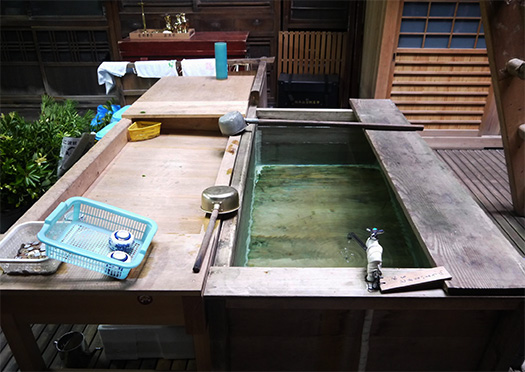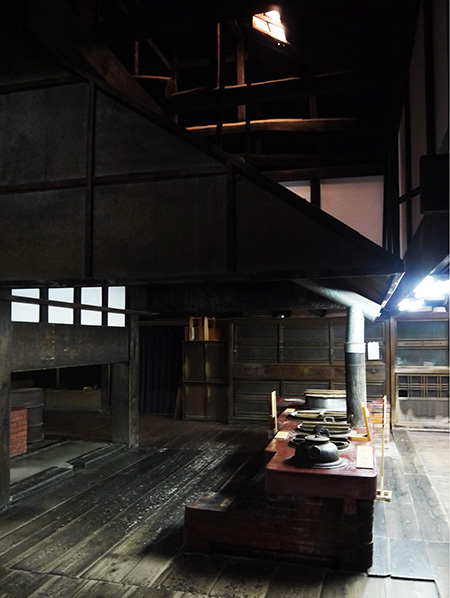


実はわたし、金剛峯寺でいちばん面白く感じたのはこの「台所」。
年間の来訪者も有数の観光地なのでガイドみたいな「流れ」があって
その最後あたりにこの台所見学が入っているのですね。
真言宗の大本山なので日本中から修行の身の僧侶たちが集合している。
くわしくその数は知りませんが、大量の人数であることは間違いない。
で、仏門に仕える身とはいえ、食欲は当然あるし身を養う必要がある。
そういう当然の生活要素に対し料理を作ることも修行という考えで
広大な作業空間が用意され、それも公開されている。
あとで説明を受けるのですが、高野山ではこの食事の担当責任者の
宗教的位階は大変高く、トップから3番目の役職とされている。
「ありがたく」食をいただくという意味で修行の重要な要素とされている。
こうした説明を受けてスッキリと受け入れることができたものです。
ちなみに、この台所を含む「本坊」全体が和歌山県の重要文化財指定。
1番上の写真は「二石釜」と呼ばれているご飯釜。
ひとつで7斗のご飯を炊くことができるのが3個あって一度に
2石・2000人分ほどのご飯が作れるのだとか。
1石というのは一人の人間が1年間食べるお米の総量と聞くけれど、
年間で考えれば730石のお米がこの高野山本山を維持するには必要となる。
よく歴史記録で寺領という水田の所有権どうこう、という記述を見るけれど
マジマジとその実態を見るようで、総量の巨大さに驚かされる。
いま現在の使用量は不明ですが、最大時にはそれくらいの人口があったか、
その用意はされていたことになる。
面白いのはこのお釜の据えられる上部には「鳥居」の木組みが建てられていること。
ご丁寧に神社のお札とおぼしき木札がその下に立て並べられている。
食という神聖行為の前では神も仏も一体のようです(笑)。
金剛峯寺正門の注連縄といい、空海さんの思想の広大無辺の一端が知れる。


台所の広大さという意味では日本でも最大級なのではないか。
こういう修行を毎日欠かさずに継続させてくることから
いわば信仰の基礎を固めてきたと見ることができる。
宗教というものが持つパワーを目の当たりに実感できます。
English version⬇
[Training place for kitchen and food Koyasan, Kongobuji Temple-12]
Actually, it was this "kitchen" that I found most interesting at Kongobuji Temple.
Since the annual tourists are also one of the leading tourist destinations, there is a "flow" like a guide.
This kitchen tour is included near the end.
Since it is the head temple of the Shingon sect, monks who practiced from all over Japan are gathering here.
I don't know the number in detail, but there is no doubt that it is a large number.
So, even though I serve the Buddhist gate, I naturally have an appetite and need to nourish myself.
In response to such a natural question, cooking is also an idea of training.
A vast work space is prepared and is also open to the public.
I will explain later, but in Koyasan, the person in charge of this meal
The religious rank is very high, and it is the third position from the top.
It is considered to be an important element of training in the sense that you will have a "thank you" meal.
I personally like to cook meals, so
I was able to accept this explanation clearly.
By the way, the entire "Honbo" including this kitchen is designated as an important cultural property of Wakayama prefecture.
The top photo is a rice cooker called "Futashigama".
There are 3 pieces that can cook 7 tons of rice at a time.
You can make rice for 2000 people with 2 stones.
I hear that one stone is the total amount of rice that one person eats for one year.
Considering the year, 730 stones of rice are needed to maintain this Koyasan Motoyama.
I often see in historical records the description of the ownership of a paddy field called a temple territory.
It seems that you are really looking at the actual situation, and you are surprised at the huge amount.
The current usage is unknown, but was there such a population at the maximum?
The preparation was prepared.
What is interesting is that the wooden structure of the "Torii" is built on the upper part of the pot.
The shrine bills and the wooden bills that seem to be shrines are carefully lined up underneath.
It seems that both God and Buddha work together in front of the sacred act of food (laughs).
It is called Shimenawa at the main gate of Kongobuji Temple, and you can see a part of Kukai's thought.
Isn't it one of the largest in Japan in terms of the vastness of the kitchen?
Because we continue this kind of training every day
So to speak, it can be seen that the foundation of faith has been laid.
You can witness the power of religion.










